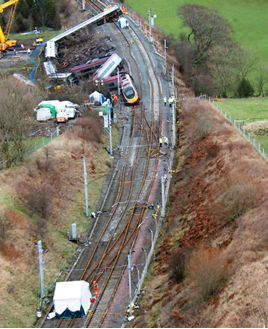It’s February 23 2007. Travelling north from London that day by rail, you have essentially two choices: the East Coast Main Line - route of the celebrated Flying Scotsman - and the West Coast Main Line, once the preserve of ‘Scots’ and ‘Coronations’ before electrification brought the AL1s and Class 87s.
You take the latter, boarding one of Virgin Trains’ Pendolinos - the tilting trains, the ‘what-the-APT-should-have-been’ trains, the trains not long from Alstom’s workshops. And at 1715, the signal having been given and the ‘right away’ received, you feel it pull out and rumble over the points at Euston’s station throat. You’re on your way to Glasgow - on City of Glasgow - or so you think…
You settle back to read, to snooze, or maybe take an early evening drink. You’re as serene as the scenes that flicker by the window at Watford Junction, Warrington and Wigan, but by Oxenholme the outlook starts to darken.
Just before 2010, the train begins to rock and sway. Bags, bottles and books begin to fly as the movement intensifies. Some think it’s a collision, some think it’s high winds. Within seconds, the wheels are bouncing on ballast… at 95mph. You hold on as all nine vehicles leave the line, eight of which jackknife down the embankment. Fortunately, you’re not in one of the five which turn on their sides, or the leading vehicle, which leaps into the air. Others aren’t quite so fortunate.
This was the first major train accident since the Ufton Nervet level crossing collision in 2004. That had been down to a suicidal motorist blocking the line. Time would tell what had happened here, but time was of the essence.
The driver, Iain Black, had been thrown from his seat and rendered unconscious, but when he came to he reached for his mobile phone and called an off-duty colleague, imploring him to tell ‘control’ to stop all traffic on the Up line. He didn’t know the derailment had already put all signals in the immediate vicinity back to danger.
The first ambulance and fire crews arrived just after 2045, and would soon be joined by RAF helicopters, the International Rescue Corps, and many others - eventually almost 500 staff would be on site. Operations were hindered by rain, darkness, and access problems caused by narrow country lanes and muddy fields. The site of the derailment - Grayrigg in Cumbria - was remote and bleak, and some emergency vehicles had to be towed by farm vehicles or tractors. The work was hard and treacherous, but by 2247 the evacuations had been completed.
Of the 109 people on board, 28 suffered serious injuries. Initially, the survivors took shelter at the local primary school. Hospitals were put on standby, though not all received patients. Most were soon discharged, but not 84-year-old Margaret Masson, who sadly succumbed to her injuries while being airlifted to safety.
Virgin Trains Chairman Richard Branson visited the site the next morning. He told reporters that Black was a hero, believing him to have “tried to stop the train” and “stay in his seat to ensure the safety of passengers”. From his hospital bed, Black told The Times he was “distraught” that Margaret Masson had died, and saddened that so many people had been injured.
Branson also paid tribute to the train, which he compared to a “tank”, adding that if it had been “old stock” then the number of “injuries and mortalities would have been horrendous”. He wasn’t wrong; imagine a Class 50 and nine Mk 1s in the same situation. But one death is one too many. One death is a shattered family, an empty seat, a void in the life of a friend.
The train derailed on a crossover at Lambrigg groundframe. It was therefore not improbable that the condition of the points was in the causal chain. Bob Crow, the late RMT leader, said as much on the BBC News. Early statements by British Transport Police Chief Superintendent Martyn Ripley backed it up. Experts drew parallels with the 2002 Potters Bar crash, and agreed that if the condition of the points was indeed in the chain then the maintenance regime was likely to be in it, too. Unlike at Potters Bar, however, the maintenance regime had been taken in-house by Network Rail, meaning private contractors weren’t in the frame this time.
A check of over 700 similar sets of points found “nothing of concern”. The Grayrigg set was removed by the Rail Accident Investigation Branch (RAIB) for what would be its most important investigation to date. The interim report concluded that the immediate cause was, specifically, the condition of the stretcher bar arrangement of the crossover’s facing points. Of the three stretcher bars - which hold the point’s moving blades the correct distance apart - one wasn’t in position and one had nuts and bolts missing. Two were also fractured.
The RAIB’s final report built on its first findings by confirming the failure of the points, and that a weekly inspection scheduled for February 18 - just five days before the accident - had not taken place. If it had, the state of the bolts would have been spotted, and the excessive residual switch opening - which resulted in the left-hand switch rail being struck by the inner faces of passing train wheels - would not have led to the ‘“rapid deterioration of the condition of the remaining stretcher bars and their fasteners”. But it didn’t, the reason being that the supervisor on the ground agreed to make a change to his inspection plan, and then forgot he’d done so. But, naturally, there was more to it than that.















Login to comment
Comments
No comments have been made yet.